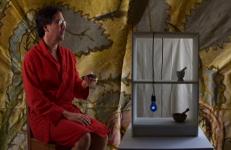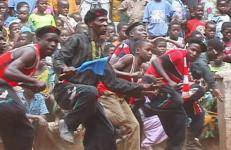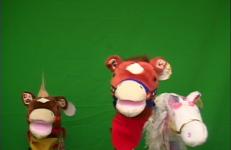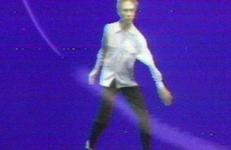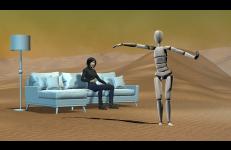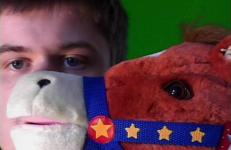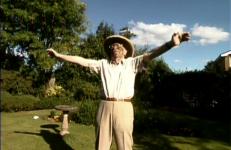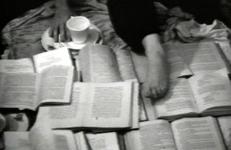Created at Eiko & Koma's home in the Catskills and set to Gamelan music, Grain was first presented during a month-long season in an East Village loft. Charles and Stephanie Reinhart were among the ten audience members one night and invited Eiko & Koma to the American Dance Festival that year. Since then, the work toured widely.
Dance
Identically dressed, and with sibling-like resemblance, performance artists Trevor Martin and Kym Olsen shift between spoken word and athletic dance choreography in a collection of 29 scenes. Set in various locations--including a gymnasium, an abandoned hospital, and a trailer park circus--Martin and Olsen slip between a ventriloquist and his dummy, a seducer and his surrogate, a doctor and his patient, and synchronized dance partners. The film examines a complex social psychology--questioning the colonization of the human body for various political, medical and religious agendas.
Identically dressed, and with sibling-like resemblance, performance artists Trevor Martin and Kym Olsen shift between spoken word and athletic dance choreography in a collection of 29 scenes. Set in various locations--including a gymnasium, an abandoned hospital, and a trailer park circus--Martin and Olsen slip between a ventriloquist and his dummy, a seducer and his surrogate, a doctor and his patient, and synchronized dance partners. The film examines a complex social psychology--questioning the colonization of the human body for various political, medical and religious agendas.
Identically dressed, and with sibling-like resemblance, performance artists Trevor Martin and Kym Olsen shift between spoken word and athletic dance choreography in a collection of 29 scenes. Set in various locations--including a gymnasium, an abandoned hospital, and a trailer park circus--Martin and Olsen slip between a ventriloquist and his dummy, a seducer and his surrogate, a doctor and his patient, and synchronized dance partners. The film examines a complex social psychology--questioning the colonization of the human body for various political, medical and religious agendas.
Home Exercises is a short dancefilm and hybrid documentary investigating the gestural habits and choreographies of aging individuals in their homes.
This title is also available as part the Movement Exercises trilogy.
Having collaborated with videographers for previous media works, Eiko & Koma decided to work alone in creating Husk. Koma adopted the role of cameraman to film Eiko's solo piece. Eiko & Koma used the playback function of the video camera to create choreography for body and camera as one long take. This media dance is presented with no editing done in post-production. Sound design by Eiko. Filmed May, 1987 at the Kampo Cultural Center, New York, NY.
"A chamber drama set in the confines of an apartment’s sun room, this video further explores visual themes and obsessions found in my earlier works and adds in a few new ones for good measure. Earlier motifs seen here are lightbulbs in pendulum movement, tabletop antics with simple household objects, Christo-like fleshy textures, sketchbook pages torn from their binders, book pages, bookshelves, and flowers. I play a vaguely Walter Mitty-ish figure, who imagines himself as a conductor, as Orpheus, and as conflicted characters in a Greta Garbo movie.
Kalan / What Remains is a dance film shot in Istanbul reflecting on excerpts from the novel Kalan by Leyla Erbil.
Dance: Leyla Postalcıoğlu
Music: Cenk Ergün, Jeff Snyder, Jason Treuting
Kuyenda N’kubvina looks at how thought and culture propagate in the slender nation of Malawi. Weaving our way through video halls, book stores, dance floors and radio stations, in cities and small villages, we meet Malawians who traffic in ideas, reflecting the rhythms of Malawian contemporary life. The video was instigated by the filmmaker’s relative ignorance about the people and culture of southeast Africa, and accompanies her as she seeks out individuals and infrastructures that channel and articulate Malawian identity.
Lament is a collaboration with video artist James Byrne. Movement material is adapted from Eiko & Koma's 1984 performance work Elegy. Sound mix by Eiko & Koma.
Commissioned by the Walker Art Center, Minneapolis, MN and made possible with funds from the National Endowment for the Arts and the Jerome Foundation, St. Paul, MN. 1986, Eiko & Koma, James Byrne, Walker Art Center. Videographed July, 1985 at the Triplex Theatre, New York, NY. Edited in 1986.
Actress Maisa Abd Elhadi was shot while protesting in 2021. This short reimagines the moment the actress danced with the forces and through creativity removed all obstacles, for herself and those before and after her.
Co-commissioned by the Next Wave Festival, The American Dance Festival, and the Lied Center at the University of Nebraska, Land is a collaboration with Native American musician Robert Mirabal and painter Sandra Lerner. Robert and his cousin and drummer Laynold Lujan live in Taos Pueblo, New Mexico, where Eiko & Koma conceived this work. Not only did Eiko & Koma visit Taos repeatedly but Mirabal also spent three months in Japan and visited the East Coast several times for this collaboration.
Ponies discover an equine Shangri-La. The audience is introduced to a classic dance step. Chubby Checker provides the musical accompaniment.
This title is also available on Ben Coonley: Post Pony Trilogy.
This video-lament for Mother Earth is a collaboration among Jim Barbaro, sound; Tobe Carey, cinematography and video editing; and Brenda Hutchinson playing a long tube.
"Made right after Covid lockdown, my art gave me an opportunity to rejoice, grieve and sonically face impermanence via sounds and a Chicken Dance I’ve been performing for decades. The beauty of this video is that it looks like Chicken Linda can finally FLY!! Please interact if you wish and dance, sing, cry, and FLY HIGH."
–– Linda Mary Montano
Focusing on the mentorship of Eiko and Koma with the young artists who study and work at the Reyum Institute of Arts and Culture in Phnom Penh, Cambodia, Cambodian Stories evokes questions of tradition, innovation, and the role of the artist in fostering social change and discoveries of new ways to leap from the canvas to the stage. Eiko & Koma's collaboration hones in on these young painters' collective energy and explores the challenges they face pursuing artistic careers in a country with little opportunity.
Merce by Merce by Paik is a two-part tribute to choreographer Merce Cunningham and artist Marcel Duchamp. The first section, “Blue Studio: Five Segments,” is an innovative work of video-dance produced by Merce Cunningham and videomaker Charles Atlas. Cunningham choreographed the dance specifically for the two-dimensional video monitor screen. Atlas uses a variety of video imaging effects, including chromakey, to electronically transport Cunningham’s studio performance into a series of outdoor landscapes. The audio track includes the voices of John Cage and Jasper Johns.
Through dancing, The Motherfucker's Birthday shows the evil of the dictator and the horror people endure under powerful political leaders. The film presents dancing, a universal and uniquely human activity often representing joy, with eerie footage of Saddam and his sons’ torture tools while they dance. Bush also dances with a smirk across the screen while announcing a war that would destabilize a whole region.
An evening-length collaboration work with the celebrated avant-garde pianist Margaret Leng Tan. The stage set is by Eiko & Koma and the lighting is by David Ferri.
Commissioned by and premiered at Japan Society, New York, October 18-20, 2007, celebrating Kazuo Ohno's 101th Birthday and the 100th anniversary of Japan Society.
The everyday performance of domestic labor is teleported into a surreal game world where an emotionally responsive AI chatbot provides no answers.
In this world, motion capture technology translates movement into data that can be unbound from the human body. Yvonne’s No Manifesto becomes a framework for understanding the existential impact of this new dataset. What happens to movement when it is divorced from affect and feeling? What happens to dance without the basic premise of embodiment and breath?
Naked is a "living" environmental installation created for and commissioned by the Walker Art Center in Minneapolis, where EIko & Koma were "on view" all the hours the museum was open for the month of November 2010. Eiko & Koma performed the total of 144 hours.
Offering was co-commissioned by Dancing in the Streets (New York), the Walker Art Center (Minneapolis, where the proscenium version premiered January 9, 2003) and the University of Arizona (Tucson).
Offering is a ritual of regeneration after loss. People everywhere have lost ideals and landscapes that were dear to them. Offering was originally developed as a mobile outdoor work. This transportable dance or living site "installation" can be brought into communities to serve a communal need for a ritual of mourning.
Introduces the audience to the rockin' talkin' pony, who provides musical accompaniment for a series of Texas country-dance lessons.
This title is also available on Ben Coonley: Trick Pony Trilogy.
Mr. Thomas is in the back garden, performing his new moves in the glorious sunlight, making things happen. Somewhere between ritual, a white suburban war dance and 1970's "keep fit" exercise to lovely music, Mr. Thomas tries to coordinate with the Black Blob, that persistently undermines the nature of his representational space...
And the song goes:
We've only just begun to live
White lace and promises
A kiss for luck and we're on our way...
Born and raised in Japan and a resident of New York since 1976, Eiko Otake is a movement-based, interdisciplinary artist. She worked for more than 40 years as Eiko & Koma, but since 2014 has been working on her own projects. Her works often investigate themes of death and dying, history, and the persistence of collective memory. Eiko has also broadened her collaborative practice to create interdisciplinary work with artists from different backgrounds and disciplines, both alive and deceased.
A "young woman who finds herself surrounded by the relics of Western culture" is the subject of Richard Foreman's formal tableaux. The narration centers on a young woman's struggle to find a relation between her body and her self as mediated by language. The text is a poetry of formal relations that carries personal and historical implications, including the desires of the woman paradoxically voiced by a male narrator. The title suggests the vivid virtuality of dreaming; scenes repeatedly refer to both reading and sleeping.








